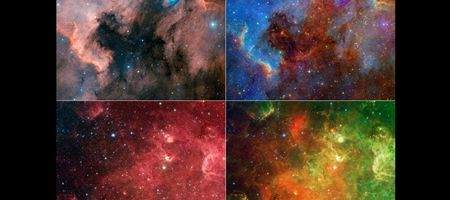The number of known young stars in the North American Nebula has taken a dramatic jump, with more than 2,000 more having been identified.

Previously, only 200 were known to exist.
Because young stars grow up surrounded by blankets of dust, they don’t appear in visible-light images – but show up beautifully to the Spitzer telescope’s infrared detectors.
“One of the things that makes me so excited about this image is how different it is from the visible image, and how much more we can see in the infrared than in the visible,” says Luisa Rebull of NASA’s Spitzer Science Center. “The Spitzer image reveals a wealth of detail about the dust and the young stars here.”
A star is created inside a collapsing ball of gas and dust. As it collapses inward, it flattens out into a spinning disk around the forming star. Jets of gas shoot out above and below the disk. Planets form out of the disk as material clumps together, and eventually most of the dust dissipates.
The new Spitzer image shows stars in all these stages.
“This is a really busy area to image, with stars everywhere, from the North American complex itself, as well as in front of and behind the region,” says Rebull.
The North American nebula still holds one mystery – namely, its power source. Nobody has been able to identify the group of massive stars that’s thought to be dominating the nebula.
The Spitzer image, like those from other telescopes, hints that the missing stars are lurking behind the portion of the nebula that resembles the Gulf of Mexico in visible-light images. Infrared light appears to be coming from behind the Gulf of Mexico’s dark tangle of clouds, ‘in the same way that sunlight creeps out from behind a rain cloud’, says NASA.
The nebula’s distance from Earth is also unclear, with current estimates putting it at about 1,800 light-years from Earth. It’s hoped that Spitzer will refine this estimate.






